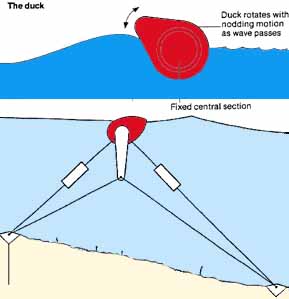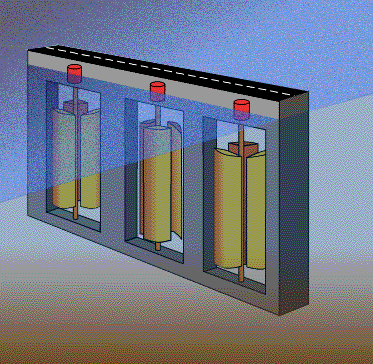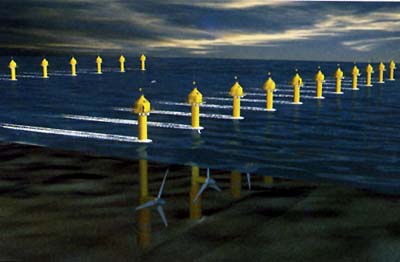 ome
Alternative Wave Power Designs
ome
Alternative Wave Power Designs
S ome
Alternative Wave Power Designs
ome
Alternative Wave Power Designs
The “Salter Duck” was developed in the 1970s by Professor Stephen Salter at the University of Edinburgh in Scotland (email Shs@srv1.mech.ed.ac.uk) and generates electricity by bobbing up and down with the waves. Although it can produce energy extremely efficiently it was effectively killed off in the mid 1980s when a European Union report miscalculated the cost of the electricity it produced by a factor of 10. In the last few years, the error has been realised, and interest in the Salter Duck is becoming intense.
Operation of the Salter Duck

Tidal Fences
Tidal fences are effectively barrages which completely block a channel. If deployed across the mouth of an estuary they can be very environmentally destructive. However, in the 1990s their deployment in channels between small islands or in straights between the mainland and island has increasingly been considered as a viable option for generation of large amounts of electricity.
B1b3_d3.1
Tidal Turbines
Tidal turbines are the chief competition to the tidal fence. Looking like an underwater wind turbine they offer a number of advantages over the tidal fence. They are less disruptive to wildlife, allow small boats to continue to use the area, and have much lower material requirements than the fences.
T idal
turbines function well where coastal currents run at 2-2.5 m/s
(slower currents tend to be uneconomic while larger ones put a lot of
stress on the equipment). Such currents provide an energy density
four times greater than air, meaning that a 15m diameter turbine will
generate as much energy as a 60m diameter windmill. In addition,
tidal currents are both predictable and reliable, a feature which
gives them an advantage over both wind and solar systems. The tidal
turbine also offers significant environmental advantages over wind
and solar systems; the majority of the assembly is hidden below the
waterline, and all cabling is along the seabed.
idal
turbines function well where coastal currents run at 2-2.5 m/s
(slower currents tend to be uneconomic while larger ones put a lot of
stress on the equipment). Such currents provide an energy density
four times greater than air, meaning that a 15m diameter turbine will
generate as much energy as a 60m diameter windmill. In addition,
tidal currents are both predictable and reliable, a feature which
gives them an advantage over both wind and solar systems. The tidal
turbine also offers significant environmental advantages over wind
and solar systems; the majority of the assembly is hidden below the
waterline, and all cabling is along the seabed.
There are many sites around the world where tidal turbines could be effectively installed. The ideal site is close to shore (within 1 km) in water depths of about 20-30m.
B1b3_d3.2